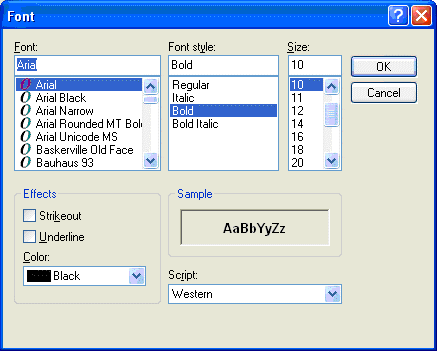IWS supports any UNICODE font available on the operating system where IWS is running. Therefore, it is possible to configure interfaces using characters for languages that do not use the standard western characters, such as Japases, Chinese, Arabic, Cyrillic, etc.
The font used on the development environment (Worksheets, Dialogs, etc.) is the default font installed by the operating system and dependent on the language of the operating system. To select a different font for development, click Font on the View tab of the ribbon.

You can set the font name, style, size, effects and script.
The icon displayed to the left of the font name indicates the font technology.
| Icon | Technology | Remarks | |
|---|---|---|---|

|
TrueType | Outline |
TrueType and OpenType fonts are outline fonts that are rendered from line and curve commands. OpenType is an extension of TrueType. Both can be scaled and rotated. Both look good in all sizes and on all output devices supported by Windows. Windows provides a selection of OpenType fonts, including Arial, Courier New, Lucida Console, Times New Roman, Symbol, and Wingdings. Type 1, by Adobe Systems, Inc., is an outline font that is designed to work with PostScript printers. The outlines can be scaled and rotated. With OpenType technology, Windows fully supports Type 1 fonts. |

|
OpenType | ||
| N/A | Vector |
Vector fonts are supported because a number of programs still depend on them. Vector fonts are rendered from a mathematical model. They are used primarily with plotters. Windows supports three vector fonts: Modern, Roman and Script. |
|
| N/A | Raster |
Raster fonts are supported because a number of programs still depend on them. Raster fonts are stored in files as bitmap images and are composed of a series of dots whether they are displayed on the screen and on paper. |
|
It is strongly recommended that you use only TrueType or OpenType fonts. Fonts designed with other technologies (e.g., Courier) cannot be scaled properly and could cause issues during runtime.